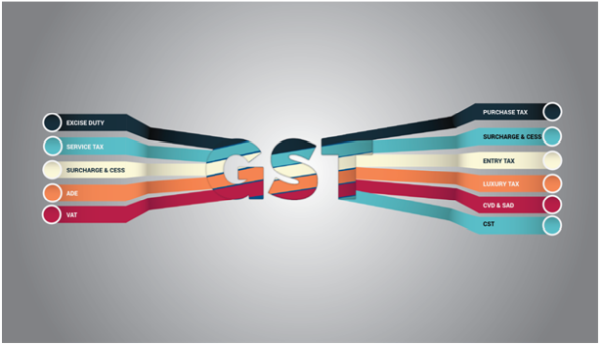The Goods and Services Tax (GST) represents the single largest tax change since India’s independence and it will eliminate multiple tax regimes and consolidate them into a single tax regime.
The following taxes will be eliminated and replaced with the GST:
- Value Added Tax / Central Sales Tax
- Service Tax
- Central Excise

Figure 1: Multiple Indirect Taxed Subsumed to GST
Many of the indirect taxes in India are Value Added Taxes, which is a common form of indirect tax used in all major economies except for the United States and Saudi Arabia. The present indirect tax landscape contains many different indirect taxes with differing applications for example, Central Excise applies to the manufacture of goods across India but VAT applies to the sale and distribution of goods within a state. Thus, businesses must follow different rules for each tax regime, which leads to mistakes, errors and penalties.
The inability to cross-utilize credits between tax regimes leads to under-utilization of input tax credits which in turn will drive up costs. Similarly, as the tax regimes are not integrated this creates a cascading effect where taxes get built into the cost of goods.
The GST has been in development for years and its design reflects India’s federal nature with portions for the state and central governments. The data exchange requirements are a nod to reducing the amount of tax evasion and tax fraud in India, and rewarding tax payers to be accurate and timely with tax amounts and compliances.
The GST creates a single set of rules for when to tax, where to tax, how to tax. The unification of the tax regime will lead to a situation where India has a single market as opposed to multiple regional markets where interstate trade is difficult, expensive, and time-consuming.

Figure 2: Inter State Transaction
The GST will have the following rates:0%, 5%, 12%, 18% and 28%
As well there are exemptions and a luxury cess will be levied so the possible number of treatments are much higher under the GST. The GST is a destination-based tax and interstate transactions will attract the IGST while intrastate transactions will attract CGST and SGST.
Depending on what you sell and buy, the GST can mean the rules for determining that tax are more complicated for example in the case of services where tax rules vary by both the type of service and the nature of the recipient. Or very similar the sale of goods sold in a state is still taxed in that state like under the old regime.
While some aspects of the GST will lead to less work in terms of tracking rates and following notifications there is a large increase in the amount of data which will need to be collected, submitted, reconciled, and analyzed on a continuous basis. The GST requires monthly compliance for most taxpayers and for the first time they will require national reporting of goods and services transactional data. Suppliers will need to upload their transactional data for their sales along with providing invoices to purchasers. Purchasers will need to ensure the data which is uploaded matches the purchase information they have on their invoices in the purchase register. This complex set of checks will ensure that input tax credits are taken correctly and fairly and there is a reduction in the amount of tax credits which are fraudulently taken. The other goal of this exercise is to increase the input tax credits taken by allowing the cross-utilization of credits for businesses which purchase goods and services and report data accurately and on time.
enComply is a solution to manage the compliance and workflow obligations under the GST, which includes the requirements to register businesses, prepare returns and collaborate across organizations or with tax partners.
enComply can help your business consolidate all communications and notices to and from government agencies in a single location and this can be displayed on a dashboard which can help you keep track of where you are in the tax processing lifecycle.
Any organization filing GST returns will need to be able to manage, manipulate and transform data to be successful in the GST. Consider the following for each invoice uploaded to the GSTN the following data must be provided:
- Date
- Value
- Place of Supply
- Reverse Charge
- Provisional Assessment
Then per line the following information must be provided:
- Type of transaction
- HSN or SAC
- Transaction Value
- Tax rates (IGST, SGST, CGST)
- Tax Amount (IGST, SGST, CGST)
All the information relevant to the transactions are uploaded to the GSTN and then reconciled against data you receive from your vendor. Businesses need a solution that can transforms data, execute rules against data, transform data and reconcile data. In a single month, a business could have to manipulate thousands of pieces of data to complete its filing obligations and this has to be done in a short period of time.
Under the GST, all outward transactions are uploaded into the GSTN by the 10th of the following month, the inward transactions by the 15th and the returns filed on the 20th. Even with processes in place upstream to improve tax data quality, a solution with powerful processing power and scale is necessary.
Even the smallest business with 300 transactions a month could be looking to reconcile and match thousands of pieces of data.
enComply is powered by a world-class GRC platform which provides you the connections you need to the GSTN to upload and reconcile data. enComply ensures data quality through predefined rules so you are uploaded acceptable data to the GSTN that counterparties can you use for their compliance obligations. The platform underlying enComply gives any business the ability to have enterprise level power but at a reasonable cost because our platform is on the cloud and multitenant by design. This saves you money and time by not having to invest in infrastructure and maintain it.
enComply allows you to quickly file your returns and allows your partners to collaborate to file returns.
This eliminates the endless exchange of emails, phone calls and spreadsheets because your data lives in a single place. Now you have a solution, which matches the unitary nature of the GST: enComply https://www.encomply.com/








 CAclubindia
CAclubindia

